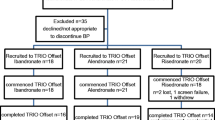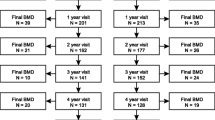Abstract
Bisphosphonates are effective agents for postmenopausal osteoporosis, but their efficacy in patients with type 2 diabetes mellitus (DM) is not known. The investigators evaluated bone mineral density (BMD) response to alendronate in women with concurrent late postmenopausal osteoporosis and type 2 DM. In a retrospective, matched case-control study, 26 late postmenopausal osteoporotic women with type 2 DM (age, 67.6±7.3 y; type 2 DM duration, 12.8±6.8 y; duration of menopause, 10.9±7.4 y; time on alendronate: 4.8±2.3 y; body mass index [BMI], 31.4±6.3 kg/m2) were matched with 26 controls according to age, BMI, duration of menopause, and alendronate treatment received. All subjects were given alendronate 10 mg/d or 70 mg/wk, along with sufficient vitamin D (≥400 IU) and calcium (≥1 g/d) intake, for 4.8 y. Response to alendronate therapy was determined by assessment of mean percent change in BMD of total hip, femoral neck, forearm, and lateral spine. The presence of type 2 DM resulted in no difference in spinal BMD response to alendronate therapy. In contrast, BMD in the total hip (mean percent change in BMD, −5.6% vs +1.4%;P=.096), femoral neck (−8.1 % vs +1.1 %;P=.015), and forearm (−3.6% vs +12.7%;P=.013) fell progressively from baseline in subjects with type 2 DM who were taking alendronate for 4.8 y, compared with controls. Elderly, postmenopausal, osteoporotic obese women with type 2 DM are resistant to long-term bisphosphonates, especially in regions of the hip, femoral neck, and forearm compared with the spine. The efficacy of bone resorption inhibitors in patients with type 2 DM, especially in comparison with anabolic agents, should be considered in additional studies.
Similar content being viewed by others
References
Stein E, Shane E. Secondary osteoporosis.Endocrinol Metab Clin North Am. 2003;32:115–134.
Hamada Y, Kitazawa S, Kitazawa R, Fujii H, Kasuga M, Fukagawa M. Histomorphometric analysis of diabetic osteopenia in streptozotocin-induced diabetic mice: a possible role of oxidative stress.Bone. 2007;40:1408–1414.
Kahn SE, Haffner SM, Heise MA, et al, ADOPT Study Group. Glycemic durability of rosiglitazone, metformin, or glyburide monotherapy.N Engl J Med. 2006;355:2427–2443.
Keegan THM, Schwartz AV, Bauer DC, Sellmeyer DE, Kelsey JL, The fracture intervention trial. Effect of alendronate on bone mineral density and biochemical markers of bone turnover in type 2 diabetic women: the Fracture Intervention Trial.Diabetes Care. 2004;27:1547–1553.
Author information
Authors and Affiliations
Corresponding author
Rights and permissions
About this article
Cite this article
Dagdelen, S., Sener, D. & Bayraktar, M. Influence of type 2 diabetes mellitus on bone mineral density response to bisphosphonates in late postmenopausal osteoporosis. Adv Therapy 24, 1314–1320 (2007). https://doi.org/10.1007/BF02877778
Issue Date:
DOI: https://doi.org/10.1007/BF02877778




